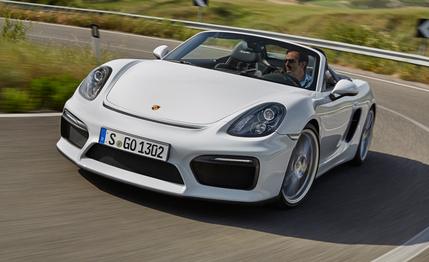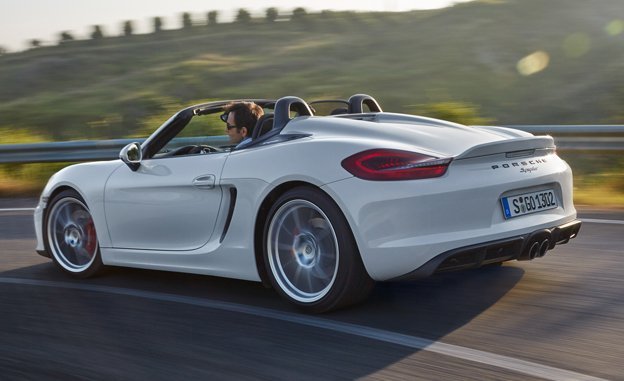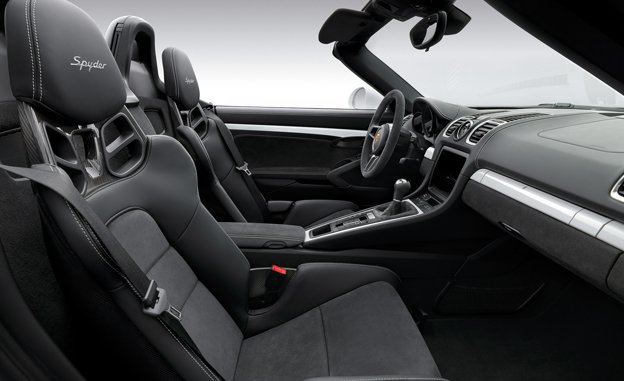
 First Drive Review
First Drive Review
Ever since the Boxster launched 19 years ago, wags have derided Porsche for not fitting the mid-engined car with a 911-grade powerplant, suggesting that the company is afraid to one-up the centerpiece of its lineup. Even Zuffenhausen’s most starry-eyed apologists have lamented the decision time and again. And it’s worth noting that while the House of Ferry trots out the 550 Spyder to tout the Boxster/Cayman’s heritage, the James Dean Deathwagen and its successors—718 RSK, RS60, W-RS, et al—were high-performance racing machines, while the rear-engined 356 stood as the car for the sporting masses.
In contrast, the Boxster has spent its career relegated to the same ignominious fate as the 914. Sure, you could buy a 914 with a six-cylinder in the early ’70s, but it was the 1969 model year’s bottom-feeding 911T engine, while the T itself received a power bump. With the Boxster Spyder, Porsche promises amends, having finally stuffed behind the seats the 3.8-liter flat-six from the 911 Carrera S.


Yet the engine is still not as powerful as it is in the 911. Porsche blames the shorter intake manifold required to make the motor fit in a mid-engined application for cutting output from 400 to 375 horsepower. As an engineer said to us in a seeming attempt to absolve Weissach of any responsibility for the power cut, “It detunes itself!” Compared with the Cayman GT4, which shares its engine with the Spyder, the Boxster is not quite as track-oriented. Whereas the GT4 receives the 911 GT3’s front suspension minus the center-lock hubs, the Spyder, essentially, is a Boxster GTS with extra displacement, foofy bodywork, and nylon-strap interior door pulls. The GT4, as is Porsche’s way with its mid-engined hardtops, is rated 10 horsepower higher than the big-bore Boxster. The message? The GT4 is the racier one.
The last iteration of the Boxster Spyder featured a fussy, skeletal flibbertigibbet of a roof. The new car’s top is simpler, although it still retains a measure of fiddliness, mainly having to do with the maddening, hidden buttons that release the canvas buttresses from their moorings. It also features a power latch operated by a console-mounted button, which somehow serves to undermine the otherwise-manual unit’s purity. We can’t help thinking that Porsche would’ve done better to ape the honest, magical simplicity of the Mazda Miata’s roof.
When stowed, the top is hidden by a large, be-flared aluminum tonneau. The revised rear visually thickens the Spyder and makes the car’s appearance exceptionally color-dependent. In Racing Yellow, the effect works. In silver, the Spyder resembles a stuffy, slab-sided ingot. In Guards Red, the vibe gets a little regrettable as in, “Ach! Fancy Jürgen took his Boxster to ze Pep Jungen!” Because the Spyder trades the GT4’s sizable wing for a stunted ducktail, the front splitter has been shortened slightly to maintain an equitable distribution of downforce.
The tight Italian roads where we flogged the car make one aware of the sheer size of the modern Boxster. Its stout exhaust note, with programmed-in overrun violence, merely adds to the beefcake gestalt. This Spyder is no light-and-lithe arachnid; it’s more godly hammer than asphalt scalpel. It does, however, remain wholly unperturbed by pavement imperfections, and the newfound power does nothing to make it twitchier. While the base 2.7-liter Boxster is a momentum-oriented machine that demands attention and revs to stay on the pace, the Spyder conspires to steamroll all manner of speed-killing sins with a liberal application of the right foot. On a tight road, leave the slick-shifting six-speed gearbox in second and drive it like a Tesla. If more than engine braking is required, the middle pedal offers confidence-inspiring, repeatable stopping power. Carbon ceramics are an option for the aesthete who simply must have the yellow calipers.


In some ways, the Spyder feels like a Johnny-come-lately answer to Ferrari’s 355, a contemporary of the original Boxster. It’s a ripped, rip-roaring muscle machine with an aural fury to match its unerring point-and-squirt dynamics. As if to underscore this, Porsche’s prescribed drive route took us through Modenese countryside. Tossing Swabian grind, blat, and pop at the ancient stone walls and reveling in the echoes felt like sacrilege of the finest order. And with such a tall second gear, there was plenty of Teutonic aural bombast to send ricocheting through towns and into the hills as we wound the Spyder up close to its 7800-rpm redline. The traction and stability nannies allow a sensible modicum of loose-booty playfulness while keeping the car fundamentally oriented toward the next apex. A versatile, predictable bruiser of a thing, this Porsche is. Come up on a hydrocarbon-belching Autobianchi caroming through the curves, find a spot wide enough to pass, depress the accelerator with a modicum of prejudice, and it’s, “Arrivederci, hairhat!”
Colin Chapman acolytes may brand us heretics, but in a car as thoroughly modern as the 981-generation Boxster, the 24-pound weight savings engendered by the Spyder’s overly complex top doesn’t seem worth the effort it took to engineer, especially when the standard powered unit is such a joy to use and results in a prettier package. Instead, the treatment merely adds needless complication and affect to a fundamentally excellent vehicle. Driving the Spyder, we realized what we’d very much like is a Boxster GTS 3.8. Before the naturally aspirated flat-six goes the way of the lesser bilby, might you please build us one of those, Porsche?